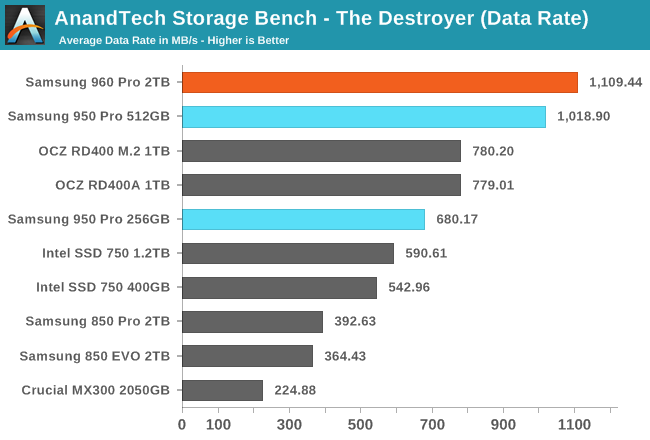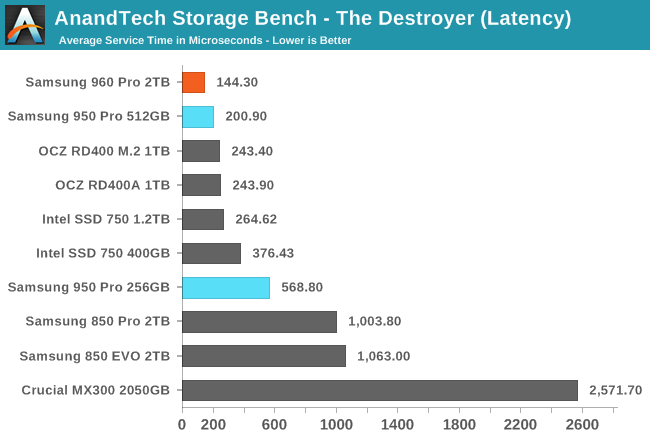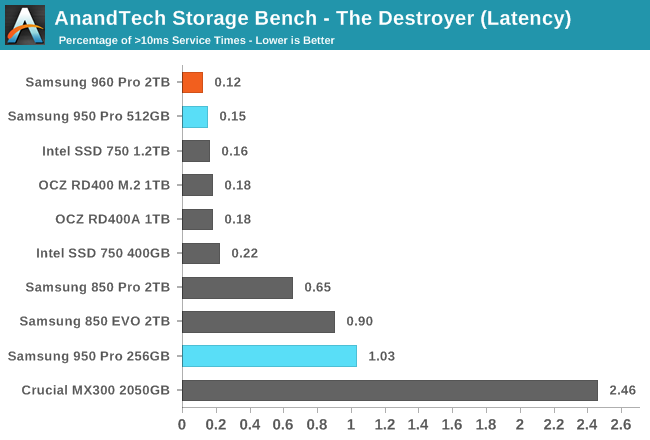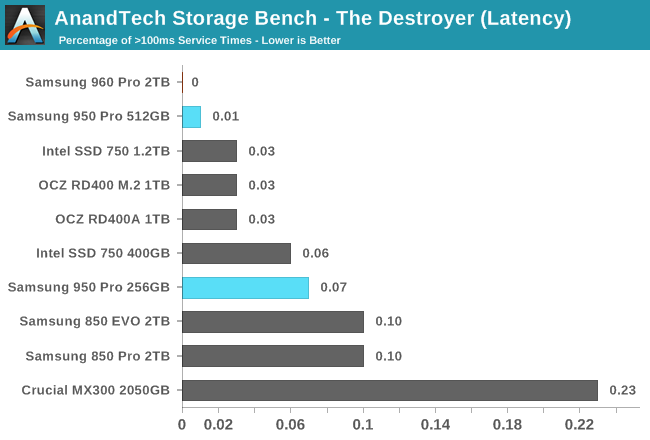The Samsung 960 Pro (2TB) SSD Review
by Billy Tallis on October 18, 2016 10:00 AM ESTAnandTech Storage Bench - The Destroyer
The Destroyer is an extremely long test replicating the access patterns of very IO-intensive desktop usage. A detailed breakdown can be found in this article. Like real-world usage and unlike our Iometer tests, the drives do get the occasional break that allows for some background garbage collection and flushing caches, but those idle times are limited to 25ms so that it doesn't take all week to run the test.
We quantify performance on this test by reporting the drive's average data throughput, a few data points about its latency, and the total energy used by the drive over the course of the test.

The 2TB 960 Pro sets a new record with a higher average data rate than the 950 Pro, but the improvement isn't huge, especially given the large increase in capacity over the 512GB 950 Pro.

The 2TB 960 Pro reduces the average service time by almost 30% compared to the next fastest drive. SATA SSDs can't deliver average service times this low even on the ATSB Light test.

For the first time, a drive has completed The Destroyer without any operations taking more than 100ms. Though at a tighter standard of 10ms, the improvement from the 950 Pro is relatively small.

Essentially no power efficiency was sacrificed for the increased performance of the 960 Pro over its predecessors, though some SATA drives are more efficient.











72 Comments
View All Comments
Billy Tallis - Tuesday, October 18, 2016 - link
The Intel 600p is very high on my to-do list. Since it's also using the Microsoft NVMe driver I want to run it through some more tests before publishing the review, but it should be done before I get the 960 EVO.WatcherCK - Tuesday, October 18, 2016 - link
Curious about the operating temperatures of the drive, Im guessing that Destroyer gave it a good thermal workout :) Puget Systems have done some testing on the effect of adding cooling to M2 SSDs:https://www.pugetsystems.com/labs/articles/Samsung...
Aquacomputer also make a PCIe Riser card equipped waterblock for M2 drives for those who want to water cool their SSD, the kryoM.2
Does anyone know if moving an M2 drive to a riser card improves cooling for the drive? I would think there is a little bit of improvement bringing the drive off the surface of the motherboard... How if at all is everyone keeping their motherboard mounted SSDs cool?
BurntMyBacon - Wednesday, October 19, 2016 - link
@WatcherCKYes, moving an M.2 drive to a riser card improves cooling (at least in my system). I checked temperatures mounted on my motherboard with a spot cooler directly on the 950Pro. I then compared it against mounting on a Silverstone ECM20 and an Asus Hyper M.2 X4 Mini (no spot cooler). If you are able to direct good airflow to the riser card, as I was, the Asus riser card is significantly cooler even though it had no spot cooler. If you use a thermal pad on the back of the M.2 drive on the Silverstone EMC20, it may in fact do even better than the Asus, but it my system, the larger standoffs allowed more air to flow behind the M.2 drive on the Asus solution. In any case, I can't seem to induce thermal throttling on my 950Pro in my setup regardless of how hard I try. Again, it will depend on how much airflow you can deliver it.
Gradius2 - Tuesday, October 18, 2016 - link
Those SSDs suffering from HEAT. If you don't put a forced cooling on them, it will DEGRADE the speed no matter what! This is why you won't see much than 3GB/s !iwod - Wednesday, October 19, 2016 - link
Where are these performance heading. Where Do we need to go. The destroyers and heavy definitely dont represent 95% of the consumer users usage. Do we need more higher Random Q1 Read Write? Or do we need higher Seq Read Write? If so then we dont need our firmware and powerful CPU core for QD32. Will that save cost? Why are we still within the 5W power usage? When can we get those dropped down to 2W or less.zodiacfml - Wednesday, October 19, 2016 - link
blazing fast. i will not be able to make useod this speed except for W10 upgradesprofdre - Monday, October 24, 2016 - link
@ Billy Talis: Would it be possible to test on another mainboard? There seems to be a clear bandwidth issue for sequential transfers, as other tech sites as https://www.computerbase.de/2016-10/samsung-ssd-96... achieved almost 3400 MB/s in CrystalDiskMark for the 512 GB model. At first they struggled to reach more than 3100 MB/s. (Samsung values were achieved with CrystalDiskMark according to computerbase).calbear88 - Tuesday, November 15, 2016 - link
Great table in the article summarizing the different Samsung NAND technologies. Here's a summary of the different types of NAND and which products they were in.27nm MLC 830 PM830
21nm MLC 840 pro
21nm TLC 840
19nm MLC XP941
19nm TLC 840 Evo
16nm MLC SM951
16nm TLC 750 Evo PM951
32 layer 86bit v-NAND MLC 850 Pro
32 layer 128bit v-NAND TLC 850 Evo
32 layer 128bit v-NAND MLC 950 Pro
48 layer 128bit v-NAND MLC 960 Pro SM961
48 layer 128bit v-NAND TLC 960 Evo PM961
Meteor2 - Wednesday, November 23, 2016 - link
How is new dies and an entirely new controller 'just a generational refresh of the 950 Pro', from any angle?anaconda1 - Monday, February 13, 2017 - link
The Samsung 2.1 driver has DPC latency issues on my end. I am usign a Samsung 960 500GB Evo nvme and using it with the Native Microsoft Driver (Windows 10 with latest updates installed) or the Samsung 2.0 driver, all is ok, DPC latency reports are fine - Latencymon and latency checker both report trouble free operation. However, installing the 2.1 driver, both Latencymon and dpc latency checker report problems with storport.sys and problems with DPC. Rolling back the driver from the Samsung 2.1 to the Microsoft or the Samsung 2.0, all goes back to normal